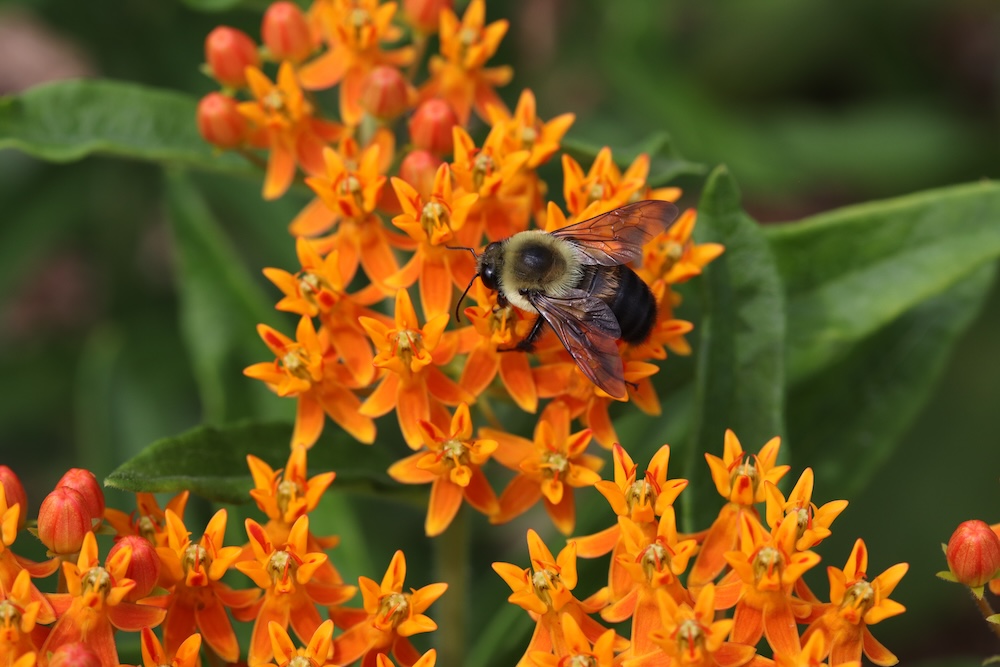Recent Headlines

Bombus griseocollis
ESF Bee Campus Survey Reveals 45 New Bee Species, Highlighting Pollinator Habitat Success
SYRACUSE, N.Y. — Dec. 12, 2024 — Once a plain stretch of lawn, the front of SUNY College of Environmental Science and Forestry’s (ESF) main administrative building bursts with the vibrant colors of a wildflower meadow in the spring and summer — a buzzing testament to the transformative power of the ESF Bee Campus initiative. Over three years, this program, part of the nationwide Bee Campus USA effort by the Xerces Society, has reimagined the college grounds with native plantings, creating vital pollinator habitats while offering students a hands-on education in New York’s ecosystems.
This year, Bee Campus elevated its efforts by documenting the species that inhabit the Syracuse campus, thanks to the flourishing pollinator-friendly plantings. Using the citizen science platform iNaturalist, the ESF community has submitted nearly 500 observations, identifying 76 species of bees, butterflies, flies, and wasps.
Starting in spring 2024, Bee Campus began conducting more formal surveys, collecting physical specimens with the help of students. Using nets to sweep individual flowering plant species, students could record valuable information about the flowers bees preferred to visit.
“Many bee species – over 90 in New York state – are pollen specialists, meaning they only forage on specific flowers. Planting these host plants on campus can attract these uncommon, rare, or imperiled specialists, and provide encouraging evidence that the pollinator gardens are improving local habitat quality,” said Molly Jacobson, ESF pollinator ecologist.
To date, the surveys netted an impressive 45 new bee species to add to the previous iNaturalist list, bringing the total to 68 bee species present on campus. The full list is available on the ESF Pollinators iNaturalist project.
In explaining the increase, Jacobson said, “Many, if not most, native bee species can’t be identified from photos, but instead need microscopic features to separate similar species.”
There is also inherent bias in what gets photographed as some bees stand out more than others and the number of students on campus fluctuates throughout the year.
The most commonly observed bees on the iNaturalist project are non-native honeybees (Apis mellifera) and (native) common eastern bumblebees (Bombus impatiens), which are abundant but don’t represent the diversity of wild bees, nor do they rely on any particular flowers, making them a poor indicator of restoration success.
The iNaturalist project also previously lacked certain groups of bees expected for the area, such as mining bees, cuckoo bees (nest parasites of other bees), and other pollen specialists. The Bee Campus survey, conducted after many native plantings were installed on campus, added 19 species of mining bees alone to the campus inventory.
The surveys also helped document non-native species expanding their ranges. Two species of masked bee, the hairy masked bee (Hylaeus hyalinatus), and the little masked bee (Hylaeus pictipes), along with the European small-woolcarder bee (Pseudoanthidium nanum), are recent introductions to North America that are on the move and appear to be established on campus.
“Urban pollinator monitoring can help track the expansion of these exotic species, as they tend to show up in cities first,” said Jacobson.
“Undertaking an inventory of bees using the pollinator habitat on campus puts ESF a step ahead,” said Jacobson. “Knowing what species occur here can help inform future plantings, whether they are planted to support current species or to attract new ones. Having information about the flowers each bee visits allows ESF to track if its plantings are why these bees are here and provide strong evidence for the value of urban pollinator habitat.”
The survey also provides ESF with more tools to educate the public about pollinators and the plants that attract them.
ESF Bee Campus will continue the inventory in 2025, as soon as the first flowers bloom in spring.
“We expect the list will continue to grow as plantings establish and new plant species are continuously added,” said Jacobson.
Learn more about Bee Campus, wild bees, and recommended native plants on the ESF Bee Campus webpage.
About SUNY ESF
The SUNY College of Environmental Science and Forestry (ESF) is dedicated to the study of the environment, developing renewable technologies, and building a sustainable and resilient future through design, policy, and management of the environment and natural resources. Members of the College community share a passion for protecting the health of the planet and a deep commitment to the rigorous application of science to improve the way humans interact with the world. The College offers academic programs ranging from the associate of applied science to the Doctor of Philosophy. ESF students live, study and do research on the main campus in Syracuse, N.Y., and on 25,000 acres of field stations in a variety of ecosystems across the state.